Hiking Gear
Author: chris | Category: Hiking Articles, Hiking Gear | Tags: communication while backpacking, ham radio, spot gps

Communication in the wilderness is possible, and there are several good options.
Communicating while backpacking might seem like the last thing that you would want to do. After all, we leave technology behind to embrace the wilderness and to focus on nature. Technology can interfere with this– there’s no better feeling than being completely “off the grid” for a week, completely disconnected from the outside world. However, there are exceptions to this- you may be backpacking alone, have health problems, or have family that needs checking on. In these circumstances, communication while camping in a remote location is not only a good idea, but a need. Thankfully, there is more than just one option when it comes to backcountry communication, and the price tag on one of the options will work with almost any budget. (more…)
17 Feb 2018
Author: chris | Category: Hiking Articles, Hiking Gear | Tags: aprs, backpacking, ham radio
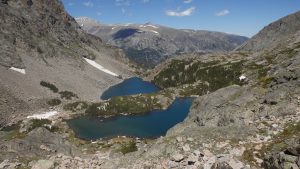
In this remote alpine setting, ham radio communication is still possible.
One of the biggest challenges with amateur radio, or ham radio, is communicating over mountainous terrain in remote regions. Natural obstacles, lack of other nearby repeaters, and logistical limitations make backpacking or hiking while operating a ham radio difficult. For someone who is new to ham radio these technical challenges can be daunting. There is plenty of information on radio specifications, repeater frequencies, and ways to overcome natural barriers on the Internet. However, the majority of resources are spread out, requiring a new ham radio operator to spend dozens of hours on research before deciding if they should bring a ham radio on a backpacking trip. This article will discuss the different ways you can overcome the many challenges that hiking with a ham radio brings. First, I’m going to cover the most important step to operating a ham radio- licensing.
(more…)
07 Feb 2018
Author: chris | Category: Hiking Articles, Hiking Gear | Tags: ham radio
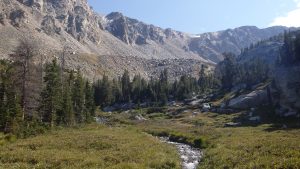
Narrow canyon walls can make operating a ham radio difficult.
Cross band repeat is a nice feature that many ham radios have– it gives the ability to transmit on one band to a more powerful radio and then, in turn, send that transmission from the more powerful radio on another band. Cross band repeat is typically used for a handheld radio to communicate with a more powerful radio, and to expand the communication range of that handheld radio. This is important when backpacking- if you can transmit using 5-8 watts to your vehicle at the trailhead, the radio in your vehicle can easily re-transmit the same message at 50-75 watts. You’ll need to do your homework with this solution, but it will easily enable you to communicate while backpacking.
(more…)
04 Feb 2018
Author: chris | Category: Hiking Articles, Hiking Gear | Tags: aprs, backpacking, ham radio
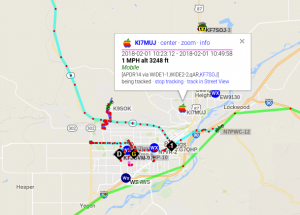
APRS Position and Course Data
Automatic Packet Reporting System (APRS) was developed in 1992 with the purpose of giving ham radio operators a way to transmit their location, allowing them to view the locations of other ham users, and send messages to each other. APRS is a mature technology, which is widely implemented in the ham community. Odds are good that there is a digipeater within range of your home. For backpackers, APRS presents an easy way to keep in touch with loved ones, while camping and hiking in the wilderness. Although APRS might sound like a hard system to operate, modern enhancements have made communicating via APRS an easy solution.
(more…)
04 Feb 2018
Author: chris | Category: Hiking Articles, Hiking Gear | Tags: aprs, direwolf, raspberry pi
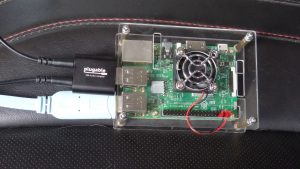
My Raspberry Pi
A computer with a sound card interfaces to your radio via two 3.5 mm audio cables. An interface cable will be required for this, which you can either make yourself or order one from Clifford Wareham (https://www.ebay.com/usr/cliffordwareham?_trksid=p2047675.l2559). Once you have your interface, you will need to determine what hardware (computer) and what software (the APRS digipeating software) you will use. For my setup, I went with a Raspberry Pi 3– a well documented and reliable miniature computer that runs Linux. The Raspberry Pi 3 does need a USB sound card in order to work as a digipeater, since the Pi only natively supports audio out. The Pi 3 and a USB sound card should cost no more than $50.
(more…)
29 Jan 2018
Author: chris | Category: Hiking Articles, Hiking Gear | Tags: aprs, backpacking, ham radio
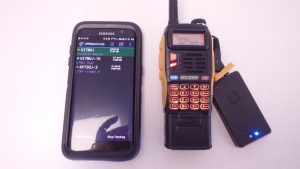
My handheld radio, running APRS thanks to the Mobilinkd Bluetooth adapter.
At times, you may find yourself unable to reliably use APRS while backpacking. Broken terrain and natural barriers can degrade your APRS transmission just enough to result in the total loss of packet information. Since APRS does not have a way to detect or recover dropped packets, some hikers get frustrated when they cannot use APRS on a backpacking trip. One way around this limitation is to setup a dedicated APRS digipeater that is located at the trailhead. This way, your weaker handheld radio can transmit an APRS message to a more powerful radio in your vehicle, which then transmits your original message at approximately ten times the power of your handheld. If you’re willing to invest a little money and time, this is not only an effective solution, but it’s also fairly easy to setup.
(more…)
29 Jan 2018
Author: chris | Category: Hiking Articles, Hiking Gear, Hiking Safety, Hiking Skills
Planning a Backpacking Trip
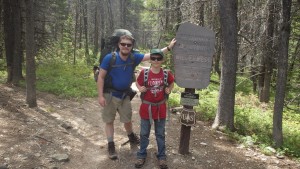
Planning a backpacking trip takes time, but the rewards are worth it.
Planning a backpacking trip is the least exciting part of backpacking. Figuring out where to go, what gear to carry, what to eat, and transportation is the backpacking equivalent to working in an accounting office. However, as an accountant is invaluable to the company that he or she works for, proper planning of a backpacking trip is equally important. Not to sound over-dramatic, but planning a backpacking trip properly can literally mean the difference between life and death. You can survive without food for weeks or drink contaminated water for days, but if you plan a trip poorly, you can die within hours.
(more…)
10 Apr 2016
Author: chris | Category: Hiking Articles, Hiking Gear, Hiking Safety
We’ve all been there- you’re 50 miles from home, and you forgot to bring your contact lens solution with you. Worse yet, you may have needed something like medication for a heart condition. Wherever you’ve been, and had a medical emergency, you’ve wished that you had the right medical supplies for that emergency. It’s this exact reason that experts recommend packing a first aid kit in your vehicle, when you take long trips. When you hike into a wilderness area, or other remote area, and are miles from civilization, there is even more of a need for basic first aid supplies. Often times, you’re days away from civilization. You don’t have the convenience of being able to walk into a store and buying supplies, when you’re in the wilderness. It’s for this reason that having a backpacking first aid kit is crucial. Once you’ve come to the realization that you need a first aid kit for backpacking, you have to determine what contents that kit will contain. When I build a first aid kit, I like to first examine what unique specialty items to include in the kit.
(more…)
19 Mar 2015
Author: chris | Category: Hiking Articles, Hiking Gear
 I have always loved winter hiking. Nothing beats the feeling of snow under your boot, and knowing that you probably won’t see another person all day long. These once busy mountains are now devoid of any sign of human influence, and the scenery this time of year is absolutely amazing. Hiking in this alpine paradise has one major drawback- the unpredictable and deadly weather. If you want to enjoy the beautiful winter views in relative safety, you need to plan your hike ahead of time- and that plan will include extra gear.
I have always loved winter hiking. Nothing beats the feeling of snow under your boot, and knowing that you probably won’t see another person all day long. These once busy mountains are now devoid of any sign of human influence, and the scenery this time of year is absolutely amazing. Hiking in this alpine paradise has one major drawback- the unpredictable and deadly weather. If you want to enjoy the beautiful winter views in relative safety, you need to plan your hike ahead of time- and that plan will include extra gear.
(more…)
18 Mar 2015
Author: chris | Category: Hiking Articles, Hiking Gear
We’ve all been there- you’re standing in front of your backpack, and you sigh while looking at it’s contents. “Do I really need all of this crap”, you say to yourself. Well, let’s break down what you need, and what you don’t need. Even if you travel light, you’ll still want to check out this list. This is a list of all the hiking gear you need to hike with, whether if you are doing a day hike, or an overnighter. This is some essential gear that can save your life one day, if you need it. I’m also going to talk about some of the things that I’ve left off of this list, so you can also see what I don’t put in my pack. Just for fun, I’ve also included a list of the treats of modern life that I haul up mountains.
(more…)
18 Mar 2015
Author: chris | Category: Hiking Articles, Hiking Gear
Hiking gear can be a very sensitive topic- some hikers believe in being prepared for even the most unlikely of catastrophes, while others prefer to pack little more than a water bottle. You can load 40 pounds worth of gear in your pack, and be prepared for anything, but what’s the fun in that? Likewise, you can just take a few items in your pockets, but what happens if it rains? When you’re hiking in high elevations, you need to take extra precaution. So, here is a short list of gear that you should absolutely bring with you while hiking.
(more…)
18 Mar 2015
Author: chris | Category: Hiking Articles, Hiking Gear
We all know that you can’t safely drink water out of a river. Sure, you might know someone who swears that they don’t need to filter their water, but let’s face it- that “one guy” is always at least a little bit crazy. Water purification when hiking is absolutely a critical need on the trail. It doesn’t matter if you’re taking a couple mile day hike, or if you’re planning a multiple day hike- you need to always bring at least one method of water purification. Let’s talk about backpacking water purification, and specifically what I carry in my backpack.
(more…)
18 Mar 2015







